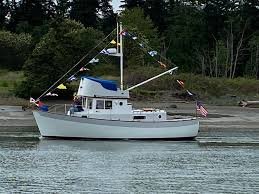Lifelong sailor here.
We will be swallowing the sail here soon, buying a trawler, and doing the great loop. We don’t know much about trawlers, learning…
We would like to do the Bahamas, and cross some of the Great Lakes.
As sailors, we have always put out a sail in lumpy seas to pin the boat over. Always.
So what’s up with a trawler? Should we be looking for a boat with a steadying sail? If not, why not? It seems very hard to find this, as least when I am looking at boats for sale….
Any advice welcome.
David
Seattle (for now)
We will be swallowing the sail here soon, buying a trawler, and doing the great loop. We don’t know much about trawlers, learning…
We would like to do the Bahamas, and cross some of the Great Lakes.
As sailors, we have always put out a sail in lumpy seas to pin the boat over. Always.
So what’s up with a trawler? Should we be looking for a boat with a steadying sail? If not, why not? It seems very hard to find this, as least when I am looking at boats for sale….
Any advice welcome.
David
Seattle (for now)
Last edited:

